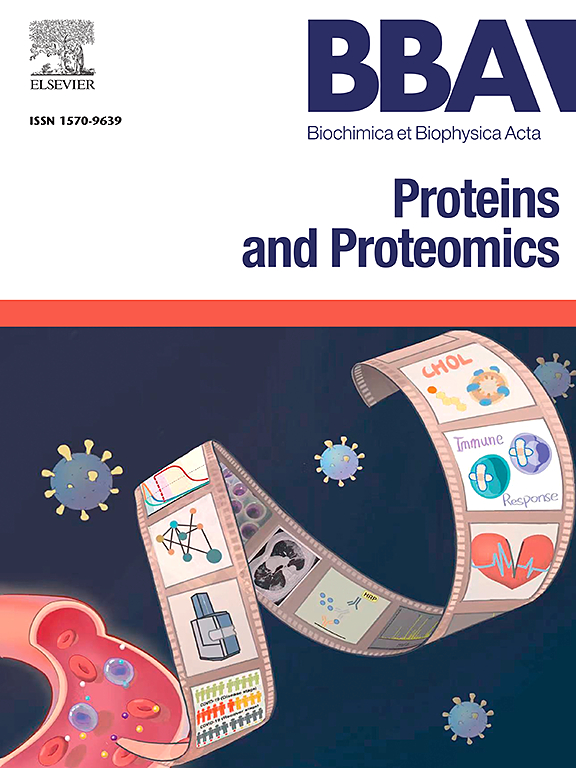Crystal structure of thymidine kinase from the multi-drug resistant col strain of Staphylococcus aureus
IF 2.3
4区 生物学
Q3 BIOCHEMISTRY & MOLECULAR BIOLOGY
Biochimica et biophysica acta. Proteins and proteomics
Pub Date : 2025-04-04
DOI:10.1016/j.bbapap.2025.141071
引用次数: 0
Abstract
Thymidine kinase (TK) is a key enzyme in the salvage pathway of thymidine that produces thymidine monophosphate. TK enzyme activity is tightly coupled to the cell cycle, exhibiting marked fluctuations in expression and activity. We report the crystal structure of TK from the Staphylococcus aureus col strain (Sa-TK), which has emerged as a promising therapeutic target. The overall structure of Sa-TK closely resembles that of human TK. The lasso region in the structure shows an open conformation due to the absence of a natural substrate. The phosphate donor site is bound with sulfate ions from the crystallization conditions. The P-loop is visible, but the complete P-β hairpin cannot be traced due to the flexibility of this region. Sa-TK assembles as a tetramer with unique inter-subunit interactions involving salt bridges between charged residues. Glu136 and Arg184, as well as Arg154 and Glu102 from each of the subunits, have β-sheet interactions that form salt bridges. The catalytically active site residue Glu89 is conserved, which is essential for enzyme activity. Sa-TK lacks a longer C-terminal sequence involved in mitotic regulation through proteolytic degradation, a feature that is likely absent in Sa-TK. The crystal structure of Sa-TK offers detailed insights into its structural and functional properties, highlighting its conserved nature and emphasizing the challenge of developing selective inhibitors that do not affect host TK. This detailed structural information presents a valuable opportunity for the rational design of novel antibacterial agents specifically targeting Sa-TK, offering a promising avenue for combating S. aureus infections.

多重耐药金黄色葡萄球菌col株胸苷激酶的晶体结构
胸腺嘧啶激酶(TK)是胸腺嘧啶回收途径中产生单磷酸胸腺嘧啶的关键酶。TK酶活性与细胞周期紧密耦合,表现出明显的表达和活性波动。我们报道了金黄色葡萄球菌冷株(Sa-TK)中TK的晶体结构,它已成为一个有希望的治疗靶点。Sa-TK的整体结构与人类TK非常相似。由于缺乏天然底物,结构中的套索区呈开放构象。磷酸盐供体位点与结晶条件下的硫酸盐离子结合。P环是可见的,但由于该区域的灵活性,无法追踪完整的P-β发夹。Sa-TK作为四聚体组装,具有独特的亚基间相互作用,涉及带电残基之间的盐桥。来自每个亚基的Glu136和Arg184以及Arg154和Glu102具有β-薄片相互作用,形成盐桥。催化活性位点Glu89是保守的,这对酶的活性至关重要。Sa-TK缺乏通过蛋白水解降解参与有丝分裂调节的较长的c端序列,这一特征可能在Sa-TK中不存在。Sa-TK的晶体结构提供了对其结构和功能特性的详细见解,突出了其保守性,并强调了开发不影响宿主TK的选择性抑制剂的挑战。这些详细的结构信息为合理设计特异性靶向Sa-TK的新型抗菌剂提供了宝贵的机会,为抵抗金黄色葡萄球菌感染提供了一条有希望的途径。
本文章由计算机程序翻译,如有差异,请以英文原文为准。
求助全文
约1分钟内获得全文
求助全文
来源期刊
CiteScore
8.00
自引率
0.00%
发文量
55
审稿时长
33 days
期刊介绍:
BBA Proteins and Proteomics covers protein structure conformation and dynamics; protein folding; protein-ligand interactions; enzyme mechanisms, models and kinetics; protein physical properties and spectroscopy; and proteomics and bioinformatics analyses of protein structure, protein function, or protein regulation.

 求助内容:
求助内容: 应助结果提醒方式:
应助结果提醒方式:


